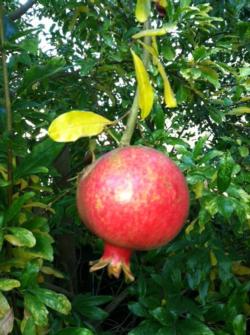Unused stories
Growing In Your Garden Now - Pomegranates

There’s a reason why pomegranates look and feel exotic. This gorgeous food is associated with the most ancient civilizations in the Middle East and Greece. Not surprisingly, it relishes hot, dry regions such as California’s central valley – especially if you want to pull out its maximum sweetness. Doesn’t get to 105 degrees all summer in your neighborhood? It’s also an excellent 15 to 20 foot ornamental shrub or small tree for sunny but cooler areas, sporting brilliant orange-red flowers in summer, followed by leathery globes and yellow foliage in the fall (and no leaves in winter in desert and interior regions). Here’s how to grow it.
Pomegranates aren’t as picky as many other fruit trees when it comes to soil. They like loam the best, but sandy or clay soils will do. They even tolerate some slow drainage and alkaline soil, but growth, fruit, and yield will suffer. Given its hometown address, it’s no surprise that it can withstand long periods of drought (though don’t expect much fruit). But here’s the cool part: if you start irrigating a pomegranate that has been subjected to many years of drought conditions, it will spring back into action and say thank you by producing an abundance of fruit. Pomegranates do not appreciate summer rainfall, which tends to soften the fruit. Your best bet is to keep soil moist during the growing season and into fall to avoid split fruit.
It’s best to pick pomegranates in August before they’re fully mature, and definitely before the rains come, which usually results in split fruit. They last for weeks and will even darken and redden at room temperature. You probably already know that, because there’s a good chance you’ve popped a few in a bowl as a decoration somewhere along the line – yet another use for this versatile, delicious, interesting food. If not, toss a few in your shopping cart next time and enjoy this beautiful fruit while it’s in season.
By Marie Narlock
